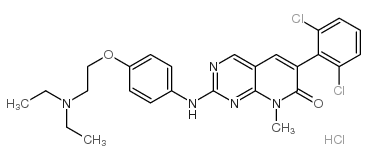212391-63-4
| Name | 6-(2,6-dichlorophenyl)-2-[4-[2-(diethylamino)ethoxy]anilino]-8-methylpyrido[2,3-d]pyrimidin-7-one,dihydrochloride |
|---|---|
| Synonyms | Heparin-Cantithrombin III |
| Description | PD0166285 dihydrochloride, a substrate of P-gp, is a WEE1 inhibitor and a weak Myt1 inhibitor with IC50 values of 24 and 72 nM, respectively. PD0166285 dihydrochloride exhibits an IC50 of 3.433 μM for Chk1[1]. |
|---|---|
| Related Catalog | |
| Target |
IC50: 24 nM (WEE1), 72 nM (Myt1), 3.433 μM (Chk1)[1]. |
| In Vitro | PD0166285 (0.5 μM) dramatically inhibits irradiation-induced Cdc2 phosphorylation at the Tyr-15 and Thr-14 in seven of seven cancer cell lines[1]. PD0166285 sensitizes radiation-induced cell killing in p53 mutant HT29 cells and in the E6-transfected, p53-null ovarian cancer cell line PA-1 but to a lesser extent in p53 wild-type PA-1 cells. PD0166285 abrogates irradiation-induced G2 arrest and significantly increases mitotic cell populations[1]. PD0166285 acts as a radiosensitizer to sensitize cells to radiation-induced cell death with a sensitivity enhancement ratio of 1.23[1]. Western Blot Analysis[1] Cell Line: Human and mouse cancer cell lines (HCT116, HT29, DLD-1, HCT8, H460, HeLa, C 26). Concentration: 0.5 μM. Incubation Time: 4 h. Result: Inhibited Cdc2Y15 and CdcT14 phosphorylation. |
| In Vivo | Animal Model: Wild-type, Abcg2-/-, Abcb1a/b-/- and Abcb1a/b;Abcg2-/- FVB mice[2]. Dosage: 5 mg/kg. Administration: IV. Result: Cmax is about 400 ng/mL. P-gp, but not BCRP, limited the brain penetration of PD0166285. |
| References |
| Melting Point | 239-242?C |
|---|---|
| Molecular Formula | C26H28Cl3N5O2 |
| Molecular Weight | 548.89200 |
| Exact Mass | 547.13100 |
| PSA | 72.28000 |
| LogP | 6.64150 |
| Storage condition | Desiccate at RT |
| Hazard Codes | Xi |
|---|
